Mechanical properties for mechanical engineering and design
Mechanical Properties
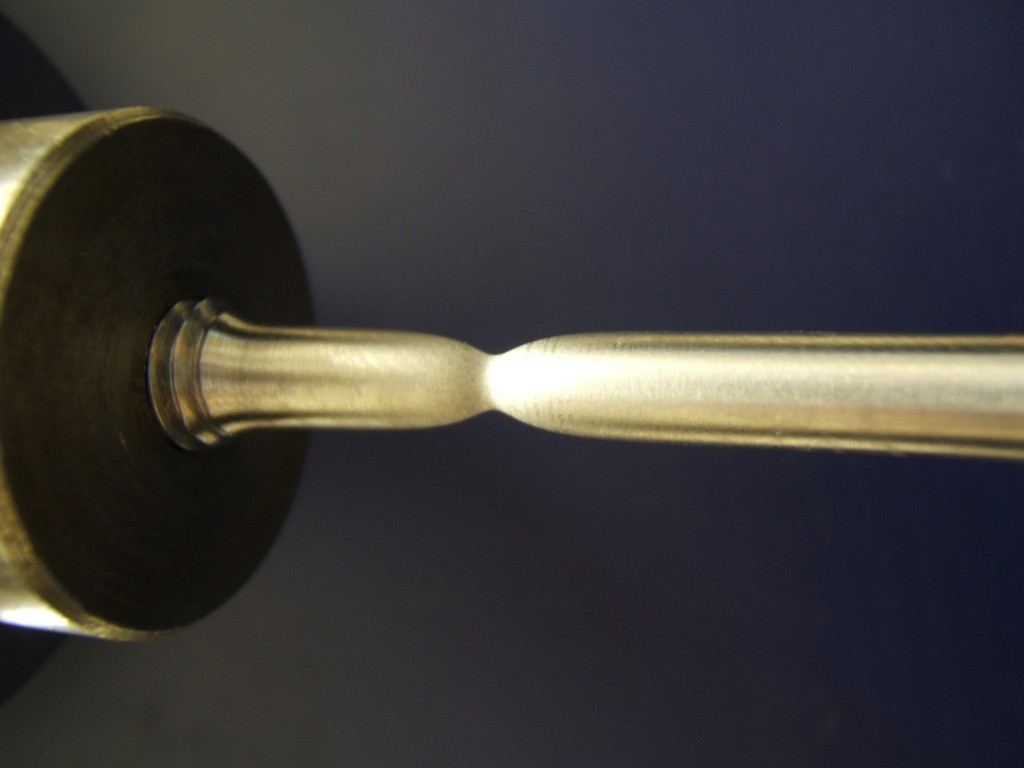
The mechanical properties of a material describe how it will react to physical forces. Mechanical properties occur as a result of the physical properties inherent to each material, and are determined through a series of standardized mechanical tests.
Strength
Strength has several definitions depending on the material type and application. Before choosing a material based on its published or measured strength it is important to understand the manner in which strength is defined and how it is measured. When designing for strength, material class and mode of loading are important considerations.
For metals the most common measure of strength is the yield strength. For most polymers it is more convenient to measure the failure strength, the stress at the point where the stress strain curve becomes obviously non-linear. Strength, for ceramics however, is more difficult to define. Failure in ceramics is highly dependent on the mode of loading. The typical failure strength in compression is fifteen times the failure strength in tension. The more common reported value is the compressive failure strength.
Tensile Strength
This is the ability of a material to withstand tensile (stretching) loads without rupture occurring. The material is in tension.

Compressive strength
This is the ability of a material to withstand compressive (squeezing) loads without being crushed or broken. The materials is in compression.

Shear Strength
This is the ability of a material to withstand offset or transverse loads without rupture occurring. The rivet connecting the two bars shown is in shear whilst the bars themselves are in tension. Note that the rivet would still be in shear if the bars were in compression.

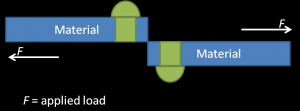
Elastic limit
The elastic limit is the highest stress at which all deformation strains are fully recoverable. For most materials and applications this can be considered the practical limit to the maximum stress a component can withstand and still function as designed. Beyond the elastic limit permanent strains are likely to deform the material to the point where its function is impaired.
Proportional limit
The proportional limit is the highest stress at which stress is linearly proportional to strain. This is the same as the elastic limit for most materials. Some materials may show a slight deviation from proportionality while still under recoverable strain. In these cases the proportional limit is preferred as a maximum stress level because deformation becomes less predictable above it.
Yield Strength
The yield strength is the minimum stress which produces permanent plastic deformation. This is perhaps the most common material property reported for structural materials because of the ease and relative accuracy of its measurement. The yield strength is usually defined at a specific amount of plastic strain, or offset, which may vary by material and or specification. The offset is the amount that the stress-strain curve deviates from the linear elastic line. The most common offset for structural metals is 0.2%.
Ultimate Tensile Strength
The ultimate tensile strength is an engineering value calculated by dividing the maximum load on a material experienced during a tensile test by the initial cross section of the test sample. When viewed in light of the other tensile test data the ultimate tensile strength helps to provide a good indication of a material’s toughness but is not by itself a useful design limit. Conversely this can be construed as the minimum stress that is necessary to ensure the failure of a material.
True Fracture Strength
The true fracture strength is the load at fracture divided by the cross sectional area of the sample. Like the ultimate tensile strength the true fracture strength can help an engineer to predict the behavior of the material but is not itself a practical strength limit. Because the tensile test seeks to standardize variables such as specimen geometry, strain rate and uniformity of stress it can be considered a kind of best case scenario of failure.
Toughness
Toughness describes a material’s resistance to fracture. It is often expressed in terms of the amount of energy a material can absorb before fracture. Tough materials can absorb a considerable amount of energy before fracture while brittle materials absorb very little. Neither strong materials such as glass or very ductile materials such as taffy can absorb large amounts of energy before failure. Toughness is not a single property but rather a combination of strength and ductility.
The toughness of a material can be related to the total area under its stress-strain curve. A comparison of the relative magnitudes of the yield strength, ultimate tensile strength and percent elongation of different material will give a good indication of their relative toughness. Materials with high yield strength and high ductility have high toughness. Integrated stress-strain data is not readily available for most materials so other test methods have been devised to help quantify toughness. The most common test for toughness is the Charpy impact test.
In crystalline materials the toughness is strongly dependent on crystal structure. Face centered cubic materials are typically ductile while hexagonal close packed materials tend to be brittle. Body centered cubic materials often display dramatic variation in the mode of failure with temperature. In many materials the toughness is temperature dependent. Generally materials are more brittle at lower temperatures and more ductile at higher temperatures. The temperature at which the transition takes place is known as the DBTT, or ductile to brittle transition temperature. The DBTT is measured by performing a series of Charpy impact tests at various temperatures to determine the ranges of brittle and ductile behavior. Use of alloys below their transition temperature is avoided due to the risk of catastrophic failure.
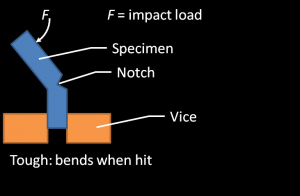
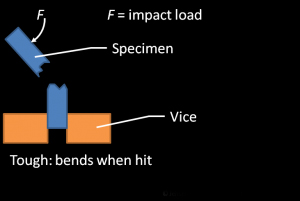
Elasticity
This is the ability of a material to deform under load and return to its original size and shape when the load is removed. Such a material would be required to make the spring as shown.
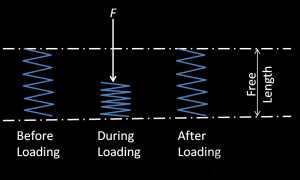
Plasticity
This property is the exact opposite of elasticity. It is the state of a material which has been loaded beyond its elastic state. Under a load beyond that required to cause elastic deformation (the elastic limit) a material possessing the property of plasticity deforms permanently. It takes a permanent set and will not recover when the load is removed.
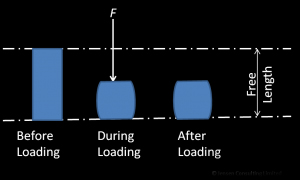
Ductility
Ductility is a measure of how much deformation or strain a material can withstand before breaking. The most common measure of ductility is the percentage of change in length of a tensile sample after breaking. This is generally reported as % El or percent elongation. The R.A. or reduction of area of the sample also gives some indication of ductility.\
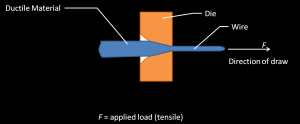
Malleability
This is a term used when plastic deformation occurs as the result of applying a compressive load. A malleable material combines the properties of plasticity and compressibility, so that it can be squeezed to shape by such processes as forging, rolling and rivet heading.
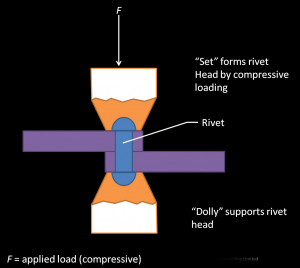
Hardness
This is the ability of a material to withstand scratching (abrasion) or indentation by another hadrd body. It is an indication of the wear resistance of a material.
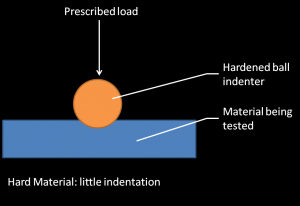
Processes which increase the hardness of materials also increase their tensile strength. At the same time the toughness of the material is reduced as it becomes more brittle.
Hardenability must not be confused with hardness. Hardenability is the ability of a metal to respond to the heat treatment process of quench hardening. To harden it, the hot metal must be chilled at a rate in excess of its critical cooling rate. Since any material that cools more quickly at the surface than tat the centre there is a limit to the size of bar which can cool quickly enough at its centre to achieve uniform hardness throughout. This is the ruling section for the material. The greater its hardenability the greater will be its ruling section.
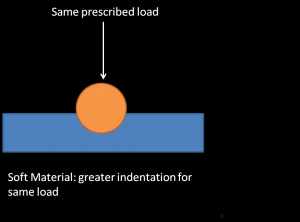
Fatigue ratio
The dimensionless fatigue ratio f is the ratio of the stress required to cause failure after a specific number of cycles to the yield stress of a material. Fatigue tests are generally run through 107 or 108 cycles. A high fatigue ratio indicates materials which are more susceptible to crack growth during cyclic loading.
Loss coefficient
The loss coefficient is an other important material parameter in cyclic loading. It is the fraction of mechanical energy lost in a stress strain cycle. The loss coefficient for each material is a function of the frequency of the cycle. A high loss coefficient can be desirable for damping vibrations while a low loss coefficient transmits energy more efficiently. The loss coefficient is also an important factor in resisting fatigue failure. If the loss coefficient is too high, cyclic loading will dissipate energy into the material leading to fatigue failure.
|
Mechanical properties for mechanical engineering and design |
|
|
Mechanical properties for mechanical engineering and design.pdf |
|


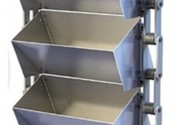
had a confusion between Plasticity & Malleability & Ultimate Tensile Strength please do explain in structure way to get more idea about properties of mechanical engineering design…